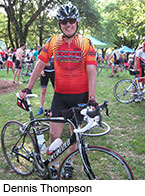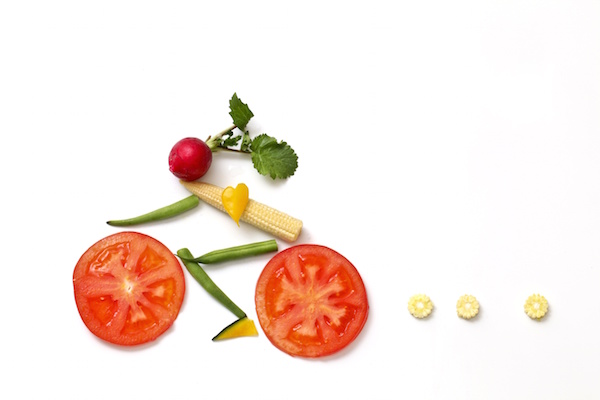
FRIDAY, Aug. 3 (HealthDay News) — I rolled into the St. Helens, Ore., rest stop, 172 miles into my single-day ride of the 204-mile Seattle-to-Portland Bicycle Classic, truly unsure how I was going to make it the rest of the way.
Despite my best efforts, I had hit the wall. I had been eating and drinking the entire long day, focused on replenishing the thousands of calories I’d been burning, and still it hadn’t been enough.
“When you’re out there for extended periods, your body gets depleted,” said Nancy Clark, a registered dietitian in Boston who has written about nutrition for cyclists. “It gets depleted of water, it gets depleted of calories. You want a constant infusion of carbs to fuel your muscles and brain, and liquids to replace the loss of sweat.”
Nutrition and hydration had been my two major concerns as I trained. I had only ridden in bicycle “centuries” (100 miles) before, so the STP — a one- to two-day race held on July 14-15 this year — would be double any previous exertion.
I tried different sports drinks and supplements during my training rides in the months leading up to the big event, and experimented with snacking at different times during the rides.
This, it turns out, is the right way to go. “Upon starting to train for an endurance event, you should also start to create your fueling strategy,” Clark said. “While training, you need to determine what food and fluids you prefer for fuel during exercise.”
I stopped training the week before the Seattle-to-Portland ride, to give my legs time to be fully rested.
“It takes 24 to 48 hours for muscles to become completely fueled, after you’ve tapered off your exercise,” Clark said. “You probably didn’t need to take that much time off, but it didn’t hurt.”
In the couple of days just prior to the big day, I began loading up on carbs.
Most of my life I spend counting calories, fighting to achieve my ideal weight. I am 6-foot, 1-inch tall and hover around 205 to 215 pounds, and it is a constant struggle.
That all went out the window the day before the STP. I ate a huge omelet breakfast, fresh macaroni and cheese from a cheese maker at Pike’s Place Market, and pasta Bolognese at a wonderful Italian restaurant. Gourmet cupcakes for dessert.
By resting and eating lots of carbs, I gave my legs the chance to build up large stores of glycogen — the fuel they would burn as my muscles fired all day long, spinning the bike crank and propelling me forward.
The morning of the STP, I got up at 3:45 a.m. and ate a bowl of instant oatmeal and a slice of pumpkin bread, then drank some fruit juice.
I got off the starting line at 5 a.m., and began my trek south with 9,999 other riders. I fell into fast-pace lines and kept up easily. Pace lines are important; drafting behind other riders, your exertion is cut by a third.
It’s not easy to remember to take regular swigs of sports drink. I had to remind myself to reach down and pull a water bottle from its cage, lift it up for a quick gulp and then shove it back into place, pedaling all the while.
You should drink about a half-cup to three-quarters of a cup every 15 to 20 minutes, to replenish what you’re losing through sweat, said Susan Kleiner, a Seattle registered dietitian who has written about eating for strength. That’s a lot harder than it sounds when you’re keeping up constant exertion to stay with a pace line.
Snacking was easier. I’d filled a little speed box that sits on my top tube next to the handlebars with jellybeans. Every so often I’d pop a couple in my mouth. They had a triple benefit — they were tangy and tasty, they were laced with pure carbohydrates, and they provided a brief distraction. Hours on the bike can be monotonous at times.
Regular food stops are one of the best things about event rides. I had ridden the STP last year and knew the food was pretty good — sandwiches, fruit juice, cookies, pretzels and plenty of gels.
At each official rest spot I loaded up on food. There were peanut butter-and-jelly sandwiches, but I avoided those in favor of turkey wraps and the like. I had learned during training that peanut butter sits uncomfortably in my stomach.
That’s due to the high fat content of peanut butter, Kleiner said.
“Don’t eat fats around exercise, not in abundance, because that slows down digestion,” she said. “My recommendation typically is to minimize fat around exercise, but always have protein and carbohydrates beforehand.”
For the first 100 miles, my eating plan worked perfectly. I kept my water bottles filled with sports drink (I’d brought powder packets along) and snacked both on and off the bike.
At the mid-point in Centralia, Wash., I celebrated with a turkey-and-cheese sandwich and two bottles of chocolate milk.
“Chocolate milk is excellent, because it gives you a great ratio of carbs to protein,” Clark said. “It gives you sodium and calcium, and is full of high-quality protein to help repair your muscles.”
The celebration was short-lived, however. My legs grew more and more weary. Getting off the bike at a rest stop in Lexington, Wash., 143 miles in, I was hit by a powerful cramp in my right hamstring. It was so bad I had to use my bike as balance until the cramp passed.
I tend to cramp, and on my doctor’s suggestion had been taking 400 milligrams of magnesium to help counteract that. I’d taken a capsule the day before, and another with my breakfast, and another at the 100-mile mark. Now I worried it might not have been enough.
Clark said the cramps might have nothing to do with electrolytes, however. New research has found that muscles might cramp simply because they’re tired.
“When muscles get tired, they tend to get hyperactive and that’s what causes muscle cramping, according to the new study,” she said. “But you do what works for you. There’s no harm in taking that extra magnesium.”
The magnesium might have helped: That was the only serious cramp I had all day, and it was fleeting.
The ride crossed into Oregon on the Columbia River, and began a grueling stretch on U.S. 30 that contained many gradual climbs. I began to flag. I would try to latch onto a pace line, but I couldn’t keep up.
I got very tired, and things got very, very dark. I began wondering if I’d taken on an impossible challenge. I started thinking about calling my wife to come pick me up, a shameful proposition with which my mind began an annoying constant flirtation.
These dark thoughts are a sign of hitting the wall, Clark said.
“Your brain relies on blood sugar, and can turn against you when blood sugar is low,” she said. “Your brain starts telling nasty stories, like ‘I don’t want to do this, why are we doing this, I’m not having any fun.'”
I rolled into St. Helens on my last legs. The day was becoming hot, and I trudged through a mister to cool myself down before heading to the food bar.
Just looking at the sandwiches and wraps made me feel nauseated, and I knew I wouldn’t be able to keep them down. But I needed to eat. What to do?
One item on the table looked great — fresh watermelon. I gorged myself, eating six slices without a thought. I also sucked down a sports gel, which delivered 100 calories of pure sugar to my system.
I got back on the bike and rolled out of St. Helens on pure mind games, figuring no matter how bad off I was, I could still finish. It was only 30 miles, after all, just a mere training ride.
And then a miracle happened. As a pace line passed, I jumped on and found that I could keep up, even though they were riding at a brisk 21 miles per hour. The watermelon and sports gel had done the trick.
“You were just done physically. You had maxed out. And then you fed yourself,” Kleiner said. “The carbohydrate loading you do beforehand can only go s
o far.”
I’m still amazed at how quickly my body grabbed the meager fuel I had presented and used it. Clark says I shouldn’t be.
“The watermelon was light and it was juicy and it gave you the carbs that you needed in your muscles and in your bloodstream,” she said. “Think of diabetics who get into trouble and have to eat a piece of candy. Within three minutes, they’re back in order. When your body needs energy, it gets it really quickly.”
I made it the rest of the way to Portland without any problems whatsoever, as far as my body goes, although I got a flat tire at mile 200 on a Portland neighborhood street. My hands shook a little as I changed the inner tube, but I felt fine otherwise, and the sympathy I got from passing cyclists gave me some good chuckles.
I started the ride at 5 a.m. in Seattle. I crossed the finish line in Portland around 5:40 p.m.
According to my bike computer, I spent about 10 hours 40 minutes on the bike, with the remainder of the time at various rest stops. I burned about 5,000 calories.
My eating plan wasn’t perfect, as St. Helens had shown. If I ever do it again, I might follow Clark’s advice and make an even more detailed plan with hourly calorie goals.
“Sometimes it’s good to have hourly targets, to help keep you from getting into a hole,” she said.
But I did make it. I drank a couple more chocolate milks at the finish line — important for carbs and protein, remember! — and then my wife poured me into her truck for the drive home and a celebratory pizza later that night.
More information
Visit the U.S. Department of Agriculture for more on fitness and sports nutrition.

